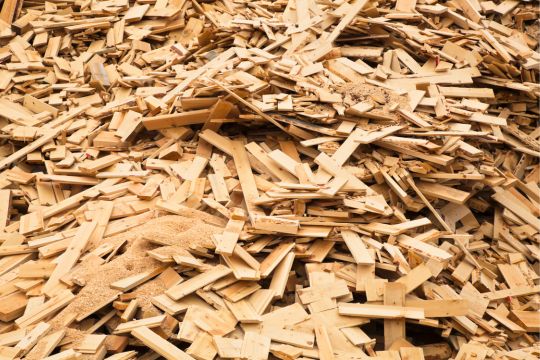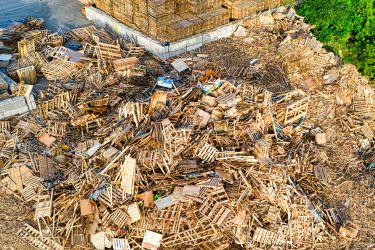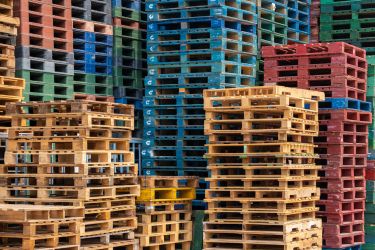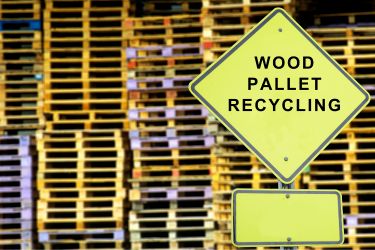
There is more to pallet waste reduction than cleaning up the splintered wood pile in the corner of your property. Effective ways to reduce waste in pallet manufacturing focus on various aspects of the manufacturing process and subsequent waste disposal. Let's take a closer look.

What you need is greater process control. It lets you use off-cuts you would otherwise scrap and use materials in more economical ways. For example, are you planning and optimizing your board-cutting processes? It sounds so simple, but when you work with consistent component sizes for various pallet designs, it is easy to cut batches of boards and avoid those small ends that are typically left over.
Other types of process control take place at the point of material purchases. Why not order lumber closer to the sizes you need for specific batch cutting runs? Moreover, make greater demands of your suppliers regarding board thickness and avoiding defects. By standardizing this element of the ordering process, you will have less waste. Process control also affects how you deal with off-cuts. Rather than tossing these pieces, use them for partial pallet repairs or sell them as kindling.
Lean manufacturing principles are popular in all types of manufacturing sectors. They are also uniquely applicable as effective ways to reduce waste in pallet manufacturing.
By now, you already know that competitors are automating many aspects of their manufacturing processes. When striving for zero-waste pallet production, considering some automation is a good idea.
For example, cut planning software maps board cuts based on the incoming lumber. It significantly reduces off-cuts. Go a step further with computer-controlled saws that focus on board length and consider defects. Examples include splits, wane, and knots that might cause you to scrap an entire board.
Although you are working on cutting boards only for current orders, there will be off-cuts. Software will help you factor in these pieces and let workers select them first during a pallet run that could use the sizes.
Rather than selling off-cuts as kindling, why not set up closed-loop scrap handling, significantly reducing waste piles on your property? Off-cuts are immediately processed into mulch. This setup is also suitable for chips cut off during manufacturing and boards that your machinery tags as defective and unusable.

Sustainability is a business model and selling point. It is also an opportunity to reduce costs in pallet manufacturing by boosting workshop efficiency. For example, you might start the manufacturing process with reclaimed lumber. Cut-optimization software and lean manufacturing principles manage raw material use.
In many cases, changing how you handle pallets in-house can minimize waste. This type of unnecessary damage prevention is the easiest shift you can make in manufacturing.
Running a sustainable pallet-making workshop also calls for solutions regarding metal waste. Reclaimed wood usually has nails or fasteners that you remove during dismantling. Set up recycling processes that keep these metals out of landfills.
In addition to using reclaimed lumber, source your boards from low-impact hardwoods or softwoods. These minimize the impact on forests. Poplar and pine trees are excellent examples of these types of woods. You might also adapt your manufacturing to work with compressed wood, bamboo, hemp composites, and coconut husks.

There will always be times when you have unused pallets you cannot sell. Some companies are also implementing drop-off options for customers who no longer need the pallets but want to keep them out of landfills. To get this type of program going, consider giving your customers incentives to return unwanted pallets.
Incoming pallets usually fall into two categories: repairs and parts salvage. Competitors already know that pallets with fork-tine damage can easily be repaired with plugs. Rather than dismantling these pallets, fix them and sell them at a discount or use them for your needs.
When determining how to recycle wooden pallets in your factory, remember to check for contaminants. Examples include mold, paint, or chemicals. Since these pallets are unsuitable for immediate reuse, repair, or parts salvage, you may need to define specific processes to handle them.
Another effective way to reduce waste in pallet manufacturing is the adherence to a closed-loop circular economy. In simplest terms, it looks like this:

It has become clear that waste in pallet making elevates manufacturing costs. Conversely, minimizing waste results in savings. How can you start the pallet cost reduction process right now?
Software is an excellent tool for accounting for every inch of usable wood and using it in the manufacturing process. It assists with streamlining the process of making pallets with new or reclaimed lumber.
Lean manufacturing is an excellent option. You can start small and continue improving your lean operations over time. Once again, some automation can be an excellent ally for this change.
Workers are frequently concerned that the introduction of software and automation means they risk losing their jobs. This is not necessarily true. Train your workers to oversee, program, and repair the machines as needed. The technology can then take over and do the precision cutting. Customers need to buy into your recycling efforts and business model change.
Many small businesses have succeeded with online workshops, YouTube videos, or blog posts that help educate customers on handling pallets properly to reduce damage and subsequent disposal. Examples of topics include forklift techniques, fork placement, load balancing, and expert maneuvering. Your customers will appreciate you taking the time to help them get the most use out of the products you sell.
By the way, if you do not want to handle pallet recycling in-house, you do not have to. Some companies specialize in recycling pallets, metals, and similar materials. They frequently pay you a small fee to take the items off your hands.
Communicating with customers is easy, and we would love to help you. In addition to working with small businesses on all types of pallet marketing solutions, our team also handles website design, social media posts, and similar tasks that quickly spread the word about your waste reduction efforts. Schedule a call today to learn more about your options!